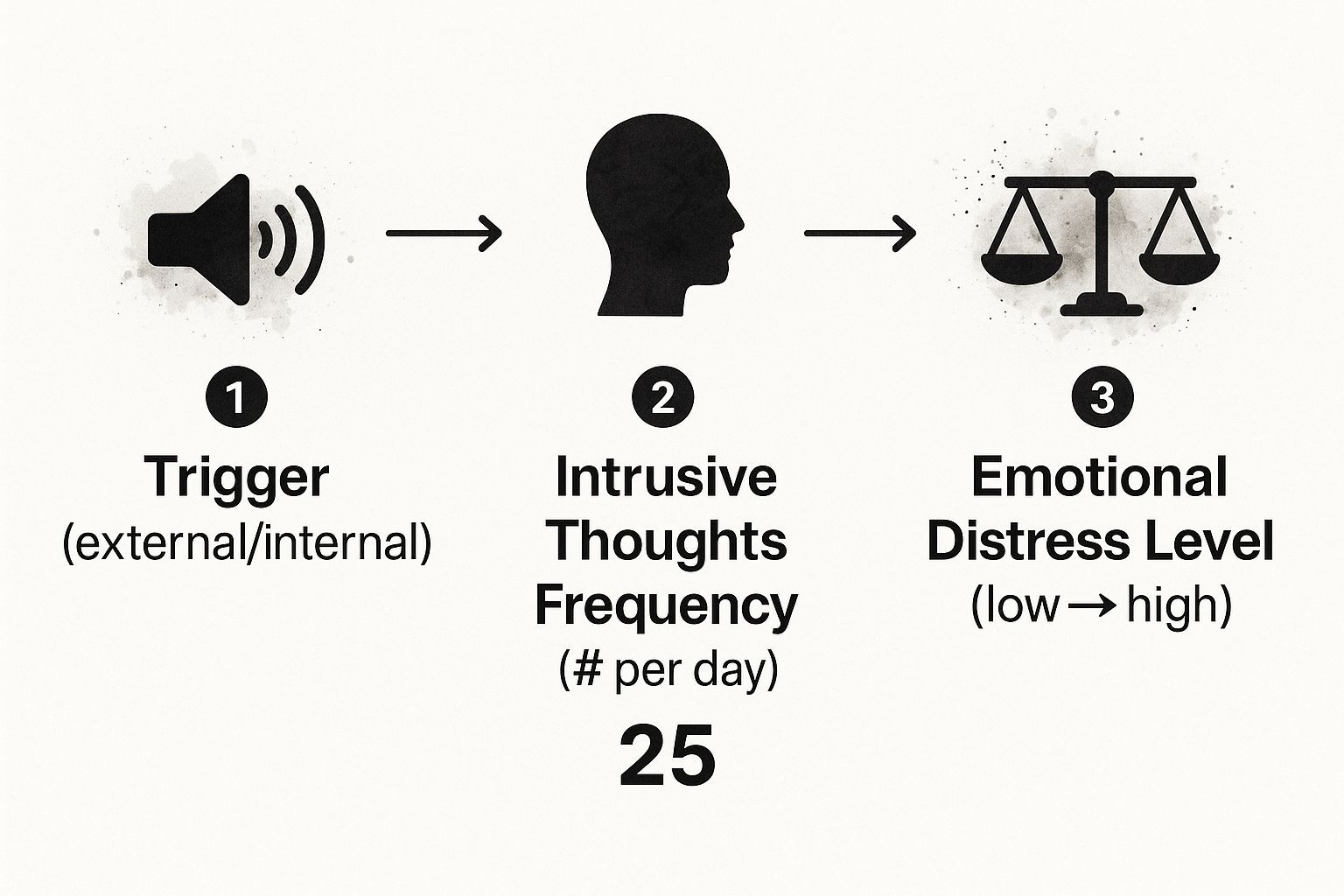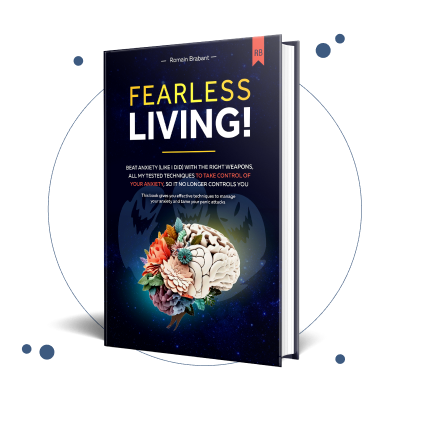
Ever been blindsided by a bizarre, upsetting, or even horrifying thought that seems to come from absolutely nowhere? If so, you’ve met an intrusive thought.
These are the unwanted, often distressing mental pop-ups that feel completely separate from your true character and desires. They show up uninvited, like spam in your inbox, but the most important thing to remember is this: they are not a reflection of who you are, and you can learn to live free from their grip.
Getting your head around that simple fact is the first, most powerful step toward managing them and reclaiming your peace.
What Are Intrusive Thoughts, Really?

Think of your mind as a busy intersection. Most of the traffic—your everyday thoughts—flows in predictable, orderly patterns. But every so often, a strange car cuts across all lanes without any warning. That jarring, unexpected vehicle is an intrusive thought.
What makes these thoughts so unsettling is that they almost always clash with your core values. A new parent who adores their baby might have a fleeting, horrifying image of harm coming to them. A genuinely kind person might have a sudden, ugly urge to shout something cruel. It’s this stark contrast that gives them their power and makes them feel so terrifying.
You Are Not Alone in This
The weight of these thoughts often comes with a deep sense of isolation. It's easy to think, "What kind of person has a thought like this?"
The answer? A perfectly normal one.
Experiencing intrusive thoughts is an almost universal part of being human. Research shows that somewhere between 90% to 99% of people have them. For most, these mental blips are just that—fleeting and easily dismissed. The hopeful news is that you can learn to see them this way, too.
The crucial difference isn't having the thought, but how you react to it. The distress you feel is actually a good sign. It proves the thought is alien to your true self, not a secret desire bubbling to the surface.
So, why do these thoughts get "sticky" for some people and not others? Often, it’s connected to underlying conditions like https://anxietychecklist.com/anxiety-disorders, where the brain’s fear circuits are a bit more sensitive. The thoughts latch on, triggering a cycle of fear and shame.
This is a common brain pattern, not a personal failing, and it is a pattern that can be changed. For more broader health and wellness insights, there are many resources that can help you understand the bigger picture of mental well-being.
To help you get a clearer picture, here’s a quick-reference table to distinguish intrusive thoughts from the everyday worries we all experience.
Identifying Intrusive Thoughts at a Glance
| Characteristic | What It Means for You |
|---|---|
| Unwanted & Uninvited | These thoughts pop into your head without you trying to think them. They feel like they come out of left field. |
| Ego-Dystonic | This is a clinical way of saying the thoughts clash with your true values, beliefs, and sense of self. |
| Distressing Content | They are often violent, sexual, or sacrilegious in nature precisely because those are the things you find most unacceptable. |
| Causes Significant Anxiety | The thought itself creates intense fear, guilt, or disgust. Your reaction is one of alarm, not curiosity or agreement. |
Ultimately, understanding what intrusive thoughts are strips them of their power. They aren't commands to be followed, predictions of the future, or secret desires. They’re just thoughts—random bits of mental noise.
Recognizing this is the foundation for reclaiming your peace of mind and starting on the path to a panic-free life.
Why Your Brain Creates Unwanted Thoughts

If you've ever been blindsided by a strange or disturbing thought and wondered, "Where did that come from?", you’re not alone. The first thing to understand is this: your brain is a thought factory, and it runs 24/7 without much of a quality control department.
Think of it as a relentless, slightly chaotic brainstorming session. It throws everything at the wall—brilliant ideas, mundane reminders, and yes, some truly bizarre or unsettling images. This isn't a flaw in your character; it's just the brain doing its job.
The problem isn't the thought itself. It's the meaning and importance we accidentally give it. Once you grasp the mechanics behind these mental intrusions, you can start to detach from the shame and learn to manage them effectively.
Triggers That Turn Up the Volume
So, why are some days worse than others? Think of certain factors as amplifiers that make the mental "spam" louder and harder to ignore. These don't create the thoughts, but they sure make them feel more urgent.
Common triggers include:
- Elevated Stress: When you're stressed, your brain’s threat-detection system is on high alert. It starts scanning for danger everywhere, which can churn out a lot of worst-case-scenario thoughts.
- Significant Life Changes: Big events—like having a baby, starting a new job, or grieving a loss—create a ton of uncertainty. This is fertile ground for intrusive thoughts to take root and grow.
- Fatigue: A tired brain has a much harder time filtering out junk. When you’re exhausted, you have fewer mental resources to dismiss a random, weird thought, so it can feel a lot more significant than it really is.
These triggers essentially prime your nervous system, making you more vulnerable to the jolt of an intrusive thought. It’s closely tied to the body's built-in alarm system. To see the full picture, our guide on the fight-or-flight response offers some great context here.
The Concept of a Sticky Brain
For some of us, especially those with conditions like Obsessive-Compulsive Disorder (OCD), the brain’s filtering system works a little differently. It's sometimes called having a "sticky brain".
In a sticky brain, an unwanted thought that most people would dismiss gets caught, like a piece of lint on a sweater. The brain’s fear center mistakenly flags it as important, replaying it over and over and demanding a reaction.
This doesn't mean your brain is broken. It just means the mechanism for letting go of irrelevant thoughts is a bit overactive—and with practice, you can learn to retrain this mechanism. The thought gets stuck not because it's true or meaningful, but simply because of this biological tendency.
Realizing that intrusive thoughts are just a mix of normal brain noise, life stress, and sometimes a "sticky" processor is a game-changer. It shifts the focus from self-blame ("What's wrong with me?") to proactive management ("How can I work with my brain?"). This is the first real step toward taking back control and healing.
So, What Do Intrusive Thoughts Usually Latch Onto?
If you’re stuck in a loop with intrusive thoughts, it can feel like you’re the only person on earth having such bizarre, disturbing mental pop-ups. That isolation is a heavy weight to carry, but the truth is, these thoughts aren't as unique as they feel. They tend to follow very predictable patterns.
Getting to know these common themes is a huge step. It helps you realize you’re not alone and that there’s a well-trodden path out of the woods toward recovery.
Intrusive thoughts have a nasty habit of targeting the very things you cherish most, which is exactly why they feel so awful and threatening. They aren't random; they're precision strikes aimed right at your deepest values. This is why a loving new mom might have a sudden, horrifying thought about her baby, or a deeply religious person might be plagued by blasphemous ideas.
The sheer distress you feel isn't a sign of a hidden dark side. It's proof of your good character. When you can look at a thought and say, "Ah, this is just a harm thought," or "This is my anxiety latching onto my relationship," you start to strip away its power.
Thoughts of Harming Others or Yourself
This is one of the most terrifying themes, hands down. It involves sudden, unwanted images or urges to cause harm—to a loved one, a stranger, or even yourself. Maybe you’re holding your baby and a fleeting, gut-wrenching image of dropping them flashes through your mind. Or you’re driving and get a sudden, bizarre impulse to swerve into traffic.
These thoughts are so jarring because they are the absolute polar opposite of who you are and what you want. The intense fear they create is actually evidence of your gentle nature. The goal isn't just to never have these thoughts again, but to learn to see them for what they are: meaningless mental noise that you can let float by without sending you into a panic. This is an achievable goal that leads to lasting peace.
Doubts About Your Relationships
Another common playground for intrusive thoughts is your romantic life, often called Relationship OCD (or ROCD). This is when your mind relentlessly attacks the certainty and security of your partnership. You might find yourself in a constant spin cycle, questioning if you really love your partner, if they really love you, or if you’re with the "right" person.
These doubts can feel incredibly real, pushing you to constantly seek reassurance or analyze every little interaction, which only fuels the turmoil. But just like other intrusive thoughts, these aren't genuine insights into your relationship. They're symptoms of anxiety that, with the right approach, can be managed so you can actually enjoy your partner without that constant nagging doubt. There is a path to feeling secure and happy in your relationship again.
Intrusive thoughts are a core feature of Obsessive-Compulsive Disorder (OCD), a condition that affects roughly 1% to 3% of people worldwide. Those with OCD often perform compulsive behaviors or mental rituals to neutralize the intense distress these thoughts cause, which makes understanding the link between the two so critical. If you want to dive deeper, you can learn more about key OCD statistics.
Unwanted Sexual or Taboo Thoughts
This theme is loaded with shame, which is why so many people suffer in silence. It involves intrusive sexual thoughts that feel deeply wrong, immoral, or completely out of line with your character. These can be thoughts about family members, children, religious figures, or even thoughts that make you obsessively question your own sexual identity (HOCD).
The shame can be overwhelming, but it’s so important to remember: they are just thoughts. It's also normal for the body to have a physiological arousal response to any sexual stimulus—even an unwanted thought—and it absolutely does not mean you want to act on it. There is so much hope here. With the right tools and support, you can learn to unhook from these thoughts and live without being held hostage by shame and fear.
Practical Strategies to Regain Control
Alright, so understanding what intrusive thoughts are and why they pop up is a huge first step. But knowing is only half the battle. Now comes the part where you move from understanding to doing. The following strategies are powerful, proven techniques designed to change your relationship with these thoughts, giving you the tools to get your inner peace back.
The most hopeful part? Realizing that control doesn't come from wrestling your thoughts into submission. Instead, true freedom is found in learning to let go of the struggle. These are your first, most important steps toward a calmer, panic-free life.
This flow chart gives you a clear visual of how a simple trigger can spiral into serious distress when we get trapped in the intrusive thought cycle.

The key takeaway here is that the thought itself isn't the real problem. It’s our reaction to it that gives it power, making it show up more often and feel way more distressing. The great news is that you can learn to change your reaction.
Acknowledge and Label Without Judgment
The next time an intrusive thought barges in, try this simple but surprisingly powerful exercise. Instead of panicking or trying to fight it, just take a mental step back and label it for what it is.
You can say to yourself, "Ah, there's that intrusive thought again," or "That's just my anxiety talking." By labeling it, you create distance. You’re not the thought; you’re the observer of the thought. This simple act of non-judgmental acknowledgment takes all the fuel out of the fire and puts you back in the driver's seat.
Allow the Thought to Simply Exist
This might sound completely backward, but one of the best things you can do is just let the thought be there without engaging with it. Imagine your mind is the sky and your thoughts are just clouds passing by. An intrusive thought is like a dark, stormy-looking cloud.
You don't need to chase it away or figure out why it's there. Just let it drift past on its own. Resisting a thought is like trying to hold a beach ball underwater—the second you let go, it shoots up with even more force. By just allowing it to float on by, you rob it of its power and teach your brain that it isn't a real threat.
Your goal is not to eliminate every unwanted thought—that's an impossible task for any human brain. The real, achievable goal is to get to a point where they no longer bother you. You can learn to see them as meaningless background noise, letting them come and go without wrecking your peace. This is the definition of true recovery.
Return to the Present with Grounding
When a thought throws you into a spiral, your mind is stuck in a scary, hypothetical future. Grounding techniques are your anchor to the here and now, pulling you back to safety. They are simple, sensory-based exercises that shift your focus from the chaos inside your head to the real world around you.
For a deeper dive, you can explore a variety of powerful grounding techniques for anxiety that offer immediate relief. One of the most common and effective methods is the 5-4-3-2-1 technique:
- 5: Name five things you can see around you.
- 4: Acknowledge four things you can feel.
- 3: Listen for three things you can hear.
- 2: Notice two things you can smell.
- 1: Name one thing you can taste.
This exercise forces your brain to concentrate on the tangible world, interrupting the anxiety cycle and proving that, in this moment, you are safe.
Effective Coping Techniques at a Glance
Navigating intrusive thoughts is all about having the right tools for the right moment. Some strategies are great for immediate relief, while others help build long-term resilience. This table breaks down a few key techniques to help you see how they work and when they might be most helpful for you on your healing journey.
| Technique | How It Works | Best For… |
|---|---|---|
| Labeling | Creates mental distance by identifying a thought as "just a thought" instead of a reality. | Interrupting the initial panic and stopping a thought from spiraling. |
| Allowing (Floating) | Involves letting the thought exist without fighting or engaging with it, like a cloud passing in the sky. | Reducing the power and emotional charge of recurring, sticky thoughts. |
| Grounding (5-4-3-2-1) | Uses your five senses to pull your focus out of your head and into the present moment. | Getting immediate relief when anxiety feels overwhelming or you feel dissociated. |
| Mindfulness | Broadens your awareness to include the thought as just one part of your experience, not the whole thing. | Building a long-term practice of non-judgment and emotional regulation. |
Remember, no single technique is a magic bullet. The real power comes from experimenting to find what combination works best for you and your unique nervous system. Think of these as skills—the more you practice, the more natural and effective they become, paving the way for lasting change.
When to Seek Professional Support for Anxiety

Self-help strategies are powerful, but sometimes the path to real, lasting freedom from anxiety requires a guide. Deciding to get professional support isn't a sign of weakness—far from it. It’s a brave, proactive step toward taking your life back from the grip of intrusive thoughts.
So, how do you know when it’s time to reach out? If your thoughts are causing you severe, ongoing distress, getting in the way of your daily life, or pushing you into compulsive behaviors just to find some relief, that's a clear signal. Professional help can make all the difference. You don’t have to carry this weight by yourself, and a brighter, calmer future is absolutely possible.
Finding Hope Through Effective Therapy
The world of therapy can feel a little intimidating from the outside, but at its core, it's a space designed for hope and healing. When it comes to anxiety and intrusive thoughts, a few methods have proven to be exceptionally effective, offering structured, evidence-based paths toward recovery.
Two of the most successful approaches are:
- Cognitive Behavioral Therapy (CBT): This therapy is all about helping you identify and challenge the negative thought patterns that fuel your anxiety. It teaches you to reframe your relationship with intrusive thoughts, showing you how to see them as harmless mental noise instead of urgent threats that demand your attention.
- Exposure and Response Prevention (ERP): Often called the gold standard for OCD, ERP involves gradually and safely facing the thoughts and situations you fear—without resorting to your usual compulsions. This process retrains your brain to realize there’s no real danger, which helps break the exhausting cycle of obsession and anxiety.
Reaching out for support is one of the most powerful things you can do. A qualified therapist provides a safe, non-judgmental space to unpack your fears and equips you with personalized strategies to build resilience and rediscover your inner peace.
These therapies aren’t about magically eliminating every unwanted thought that pops into your head. That’s not realistic. Instead, the goal is to fundamentally change your reaction to them.
It's about getting to a place where intrusive thoughts can come and go without sending you into a spiral, allowing you to live a full, vibrant, and panic-free life. Understanding how different therapies work can be incredibly empowering, and you can explore more about psychotherapy for anxiety to see what might be the best fit for you. Working with a professional isn't an admission of defeat; it’s a hopeful, empowering journey toward lasting well-being.
Your Questions About Intrusive Thoughts Answered
https://www.youtube.com/embed/ichB-iPhvAg
Even after you start to get a handle on what intrusive thoughts are, a few stubborn, scary questions can stick around. Let's tackle those head-on. Answering them directly is a huge step toward feeling more confident and realizing that you really can feel better.
Can Intrusive Thoughts Make Me Act on Them?
This is easily the most common and terrifying question people have. The answer is a hard no. Intrusive thoughts are what experts call "ego-dystonic," which is a clinical way of saying they are the absolute opposite of your true values, desires, and character.
Think about it: the sheer horror and anxiety you feel when these thoughts pop up is the strongest proof you'll ever need that you would never, ever act on them.
The thoughts are so jarring because you are a good, caring person. It’s that clash between the thought and your true self that sparks the panic, not some secret, hidden desire. You are safe from these thoughts.
Does Having These Thoughts Mean I Have OCD?
Not necessarily. The truth is, almost everyone has a bizarre, unwanted thought from time to time. The real difference between a passing strange thought and a condition like OCD is how you react to it.
If the thoughts are relentless, cause you extreme distress, and push you to perform mental games or physical rituals just to feel safe, it might point toward an anxiety disorder. This is where a mental health professional can offer clarity and genuine support, helping you find the right path to healing.
If you're worried, taking a confidential screening like an anxiety test based on the GAD-7 can be a good first step. It can help you get a better sense of your symptoms before deciding what to do next.
Will These Thoughts Ever Go Away Completely?
The goal isn't actually to scrub your brain clean of every single unwanted thought—that’s an impossible mission for anyone. The real win, and the true essence of healing, is getting to a place where these thoughts just don't bother you anymore.
With practice and the right tools, you can learn to see them for what they are: meaningless background noise from a creative, overactive brain. You learn to let them float by without getting hooked, allowing you to live a full, peaceful life free from panic. Healing isn't just a nice idea; it is absolutely possible for you.
The journey to a calmer mind is one you don't have to walk alone. At The Anxiety Checklist, we provide practical, step-by-step tools to help you break free from the anxiety cycle and reclaim your life. Discover our Fearless Living system and start your path to healing today.

